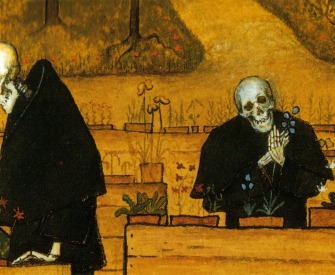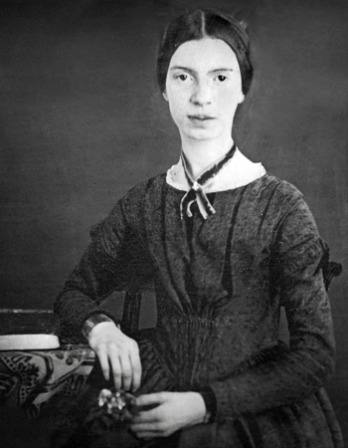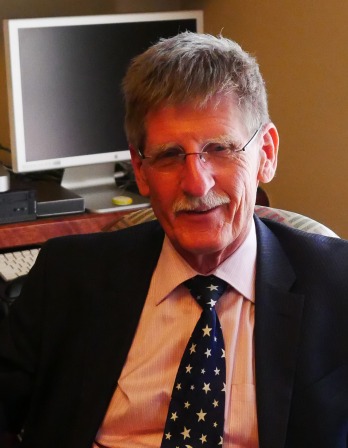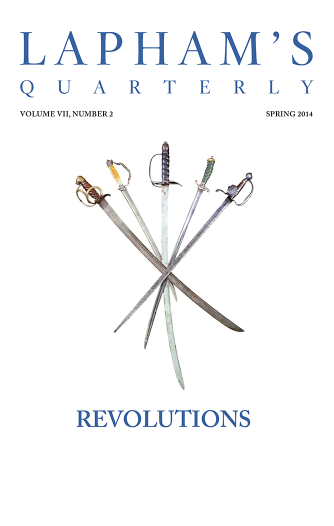The gods play games with men as balls.
—Plautus, 200 BCLearning from the Master
Norman Maclean gets a billiards lesson from America’s first Nobel Prize–winning scientist.
I would never have exchanged a single word with physicist Albert Michelson, the Master of Light, if I had not been brought up in western Montana, where all my generation spent more time in what were then called card-and-billiard parlors than in school or at home. In the early part of this century, the card-and-billiard emporium was “the home away from home,” and home was only where we ate and slept. Usually, the first table was the billiard table, because in Montana billiards was thought of as the sport of the upper class and was played only by the town’s best barbers and the one vice president of the bank. Then came three pool tables with dead cushions and concrete balls that hairy loggers hit so hard they jumped off the tables. At the rear, enthroned by several steps as at the Quadrangle Club, was the card room, in the center of which was the poker table under an enormous green shade. In the glare of the circle of light were always two or three poker players trying to look clumsy. They were housemen or “shills” waiting for some lumberjack to drop by who had just cashed his summer’s check. If you were any good at cards yourself, you could see it was hard work for them to look clumsy.
We high-school players were pool players, although we would have liked to be billiard players, if for no other reason than that each billiard player was so elite he had a woman besides a wife, but we could rarely finance our aspirations. It cost twenty-five cents an hour to play billiards, and only ten cents a game for rotation pool and, as any high-school, rotation pool player knows, it is no great trick, when the houseman is not looking, to sneak balls back on the table that have already been sunk and thus to prolong the game.
When I came to the University of Chicago as a graduate assistant, I was just as good a billiard player as the number of spare twenty-five-cent pieces I had when I was in high school, and still aspiring to be better, I ate my lunch early to get downstairs and watch the club champion.
Michelson was the best billiard player I have ever seen at the university, and I think I have seen all the really good ones, including the barbers at the Reynolds Club. At first I was somewhat embarrassed to see how good he was, because I did not expect to find any academic type as good at a “man’s sport” as the best we had in western Montana. But the more I thought about it and the more I learned about Michelson, the less surprised I became. Before long, I comforted myself with the question, “Why not? He’s the best head-and-hands man in the world.”
So it wasn’t just billiards I watched when I arrived early every noon to watch Michelson play billiards. I came to watch his hands. This was still in an age which counted men who made machines among its marvels and took for granted that the rest of men could use tools and that women could embroider beautifully. Edison still performed his wonders, but the wonders of Bell and Edison were more or less household utilities. Michelson’s head and hands made machines almost godlike in properties, designed to tell us how it was with the universe. His favorite creation was his interferometer, with which, among other things, he (and later his collaborator, Edward Morley) had performed an experiment that shook the old universe and gave Einstein a big push toward creating a new one with his theory of relativity.
Before the Michelson-Morley experiment, the common scientific assumption was that the universe consisted of bodies of matter moving through and permeated by a substance that, although invisible, had somehow itself to be material. This substance at first was spelled “aether.” Since Michelson tended to believe that the major theories of the universe were already in and that accordingly the chief jobs left to do were to measure what was sailing around in the ether, his head and hands produced his interferometer which split a light wave, sending one half with the orbit of the earth and back again where it met the other half wavelength that had been sent on a return trip at right angles to the orbit of the earth. If there were ether out there (unless it were being carried along by the earth as if it were an envelope of the earth), the expectation was that when the two halves of the light wave rejoined they would be “out of phase,” since one had held a course parallel to “the ether drift” and the other had crossed it at right angles and returned. The difference between the two half-light waves would indeed be small, but Michelson was sure he could measure it—and measure it he did, again and again—only to conclude reluctantly that there was no difference and that therefore there was no stationary ether “out there” and the light traveled at equal velocity in all directions.
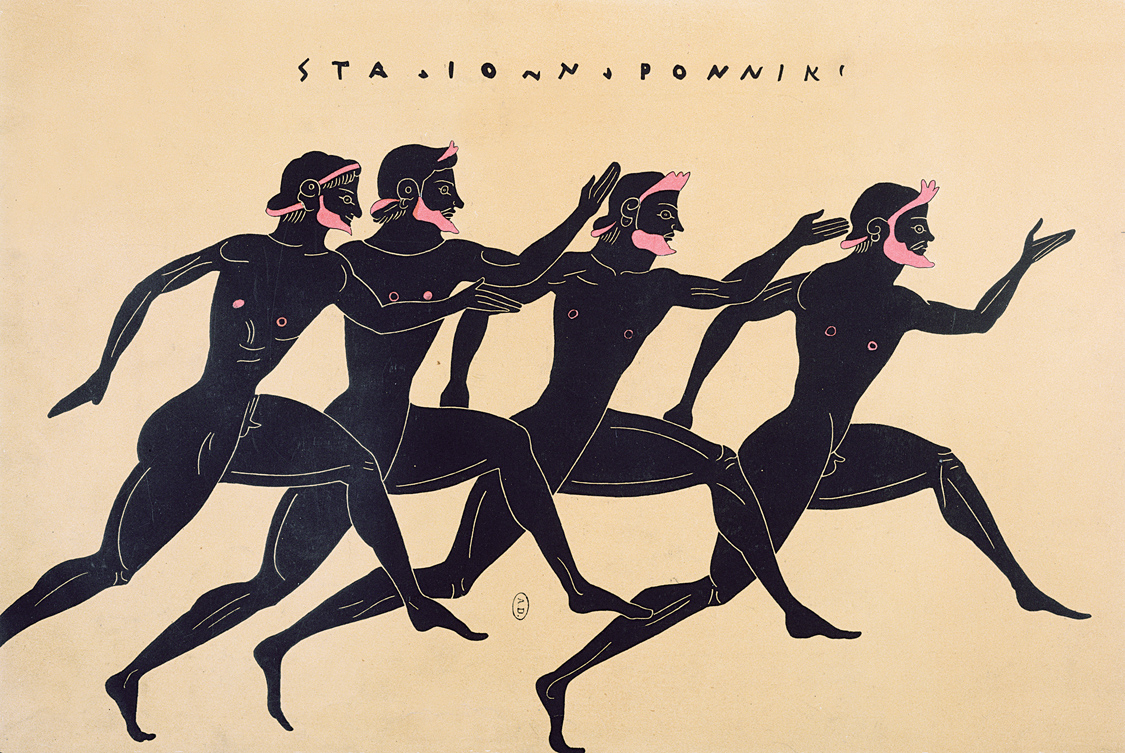
Athletes in a footrace, French lithograph after an ancient Greek vase, c. 1850. © Bibliotheque des Arts Decoratifs, Paris/Archives Charmet/The Bridgeman Art Library International.
In 1928 we only crudely knew how these negative results of the Michelson-Morley experiment opened the universe to Einstein’s theories of relativity, and we had even vaguer notions of the kind of machine that left Newtonian physics lying in a heap feebly struggling to get out from under its own ruins.
No wonder that before long the astronomers tried to enlist Michelson’s hands in their service and succeeded. Dissatisfied with their own attempts, they urged him to give them the first accurate measurement of a star. For the first star ever to have its diameter measured accurately, he picked a big one with a big name a long way off—Betelgeuse, linear diameter 240,000,000 miles (2,300 times larger than our sun) and 150 light years from the earth.
His hands were legendary long before I ever saw them. As legend, they were part fact and some fiction. For instance, I soon heard he was a fine violinist and a mini-Stradivarius who made his own beautiful instruments, but I think the truth is that, while his Jewish father was out selling pick handles to California gold miners, his Polish mother kept him indoors to “practice, practice, practice,” with the result that he became a fine violinist and, in his turn, spent half an hour before going to his lab in passing on his love and skill to his daughters. The business, though, about his making violins was just a fictional tribute to his hands.
It is a fact, however, that at the end of his first year at Annapolis he stood at the top of his class in drawing and that all his life he expressed himself by sketches and watercolors. Often in late afternoons if you looked over the wall in front of his beautiful home at 1220 East Fifty-eighth Street (just behind the Robie House) you could see him in the sunshine and shadow of his yard painting shadow and sunshine.
Many of his last late afternoons in Chicago he spent either in his yard or at the Quadrangle Club. In those days, before so much of the Quadrangle Club was turned into an eating place, there was a beautiful chess room on the second floor, and on late afternoons his slightly stooped shoulders were often reflected in the dark and light squares of ingrained wood. He had been good enough once to play the American chess champion, Frank James Marshall, who however was not overpowered by his unorthodox openings, as most of his opponents were, and is supposed to have remarked that the physicist’s game was a little long on imagination and passion.
He also had the reputation of having been a very good tennis player, but I have no memory of ever seeing him play; perhaps at seventy-five he had quit the game, but supposedly he had been very good.
At seventy-five, though, he was still the best billiard player in the club. He even looked like a billiard player. In fact, he looked like everything he did well—he looked like a violinist, a watercolorist, a chess player, and a physicist. And he still looked like an Annapolis-trained naval officer. He was slight, trim, and handsome. He was quietly dressed, with a high, stiff collar and a small, sharp mustache. He was small all over, and even his hands did not look particularly unusual. In fact, one of the fascinations of his hands was that they looked ordinary.
Like most of the very good “downtown players” at Bensinger’s, he seemed to shoot slowly, an obvious illusion if you kept track of the number of points he was making. It would be more accurate, therefore, to say he shot steadily and rhythmically, only occasionally taking more time to study one shot than another. Those who had seen him shoot in his prime said he was best at three-cushion billiards and credited his skill at this wide-angle game to his mastery of physics, but when I saw him play, his long game was his weakness, possibly because his eyesight was not so sharp as it had been.
What he was best at was getting the three balls close together and then “nursing” them—that is, making long runs by keeping the balls together with a soft, delicate stroke. When they slowly worked apart, he would bring them together again with a “position shot” that required an understanding of the angle each ball would take when it came off a cushion, together with perfect control of the speed and hence the distance each ball would travel. Speed and angles he had under his control. When I saw him play, he was essentially a control player.
It would be nonscientific to describe him as a great billiard player, but he was a very good amateur player. At seventy-five he could have played downtown at Bensinger’s, and he was the best billiard player in the history of the university. I saw him run over forty several times, and it was not unusual for him to put a string together of twenty or thirty; he had to start with a tough “leave” if he didn’t make five or ten.
Once he handed me his cue and said, “Shoot a few yourself.” Considering my general confusion, I thought I did pretty well. In fact, he said, “Not bad.” Then he added, “But you use ‘English’ on too many of your shots.” English comes from putting a spin on the cue ball by hitting it on one side instead of the center so that it comes off the cushion or another ball at an unusual angle. “Once in a while it is necessary to use English,” he said, “but it is hard to predict accurately. Cue your ball in the center as often as you can. Don’t use something hard to control unless you have to.”
Only this once did he hand me his cue and ask me to shoot, so once must have satisfied him that, although I wasn’t good enough to play with him, he could turn to me now and then and lift an eyebrow.
Often when he missed a shot, he stood silently studying the green cloth until (I think) he had reconstructed the preceding series of shots and had decided where he had started to lose control of the balls. Once he said when he missed a shot, “I am getting old.”
Just he and I were present, so he said this to me or himself, but I had to let him know I heard it and I have always been glad I did. I said, “No, no. It was a hard shot, but it was the one you should have taken, and you barely missed it.”
“Are you sure?” he asked.
I said, “I am sure. The easy shot would have left the balls spread all over the table. Any of the good players down at Bensinger’s would have played it the way you did, and a lot of them would have missed.”
I think that he was glad I had stopped him from blaming old age, but he was through for the day. He locked his cue into the rack on the wall, and said, either to me or himself or the wall, “Billiards is a good game.”
He made sure that his tie was in the center of his stiff collar before he added, “But billiards is not as good a game as painting.”
He rolled down his sleeves and put on his coat. Elegant as he was, he was a workman and took off his coat and rolled up his sleeves when he played billiards. As he stood on the first step between the billiard room and the card room, he added, “But painting is not as good a game as music.”
On the next and top step, he concluded, “But then music is not as good a game as physics.”
© 1975 by Norman Maclean. Used with permission of University of Chicago Press.
Norman Maclean
From “‘Billiards Is a Good Game’: Gamesmanship and America’s First Nobel Prize Scientist.” Maclean’s father taught his two sons the Bible and how to fish, a pedagogy alluded to in the opening sentence of the titular novella of his only completed book, A River Runs Through It—“In our family, there was no clear line between religion and fly fishing.” Having devoted most of his life to teaching Romanticism and Shakespeare, Maclean died at the age of eighty-seven in 1990.

